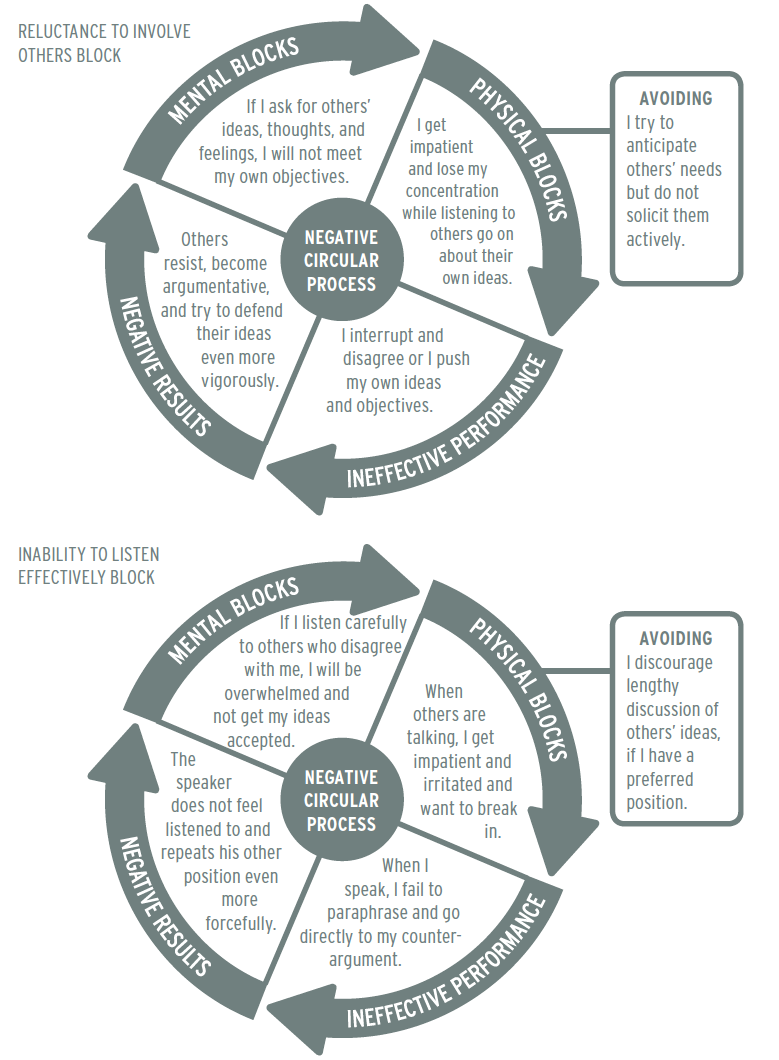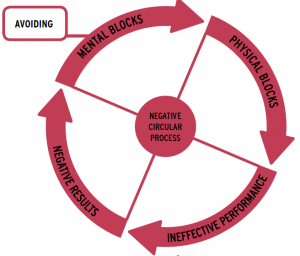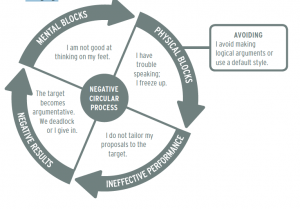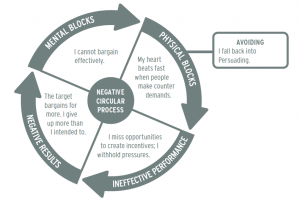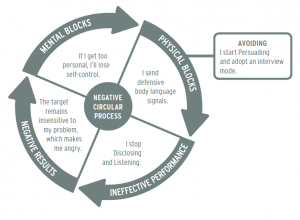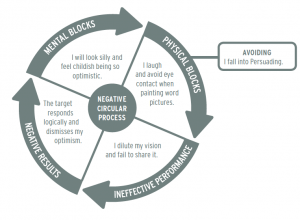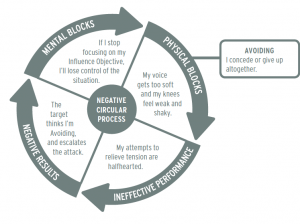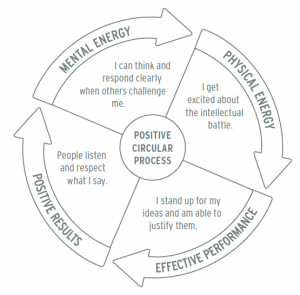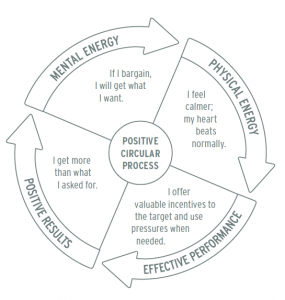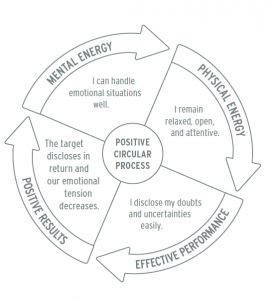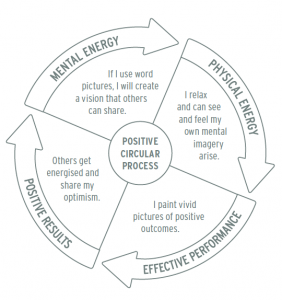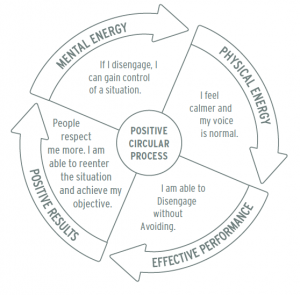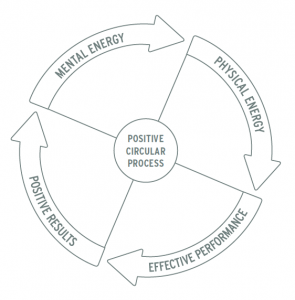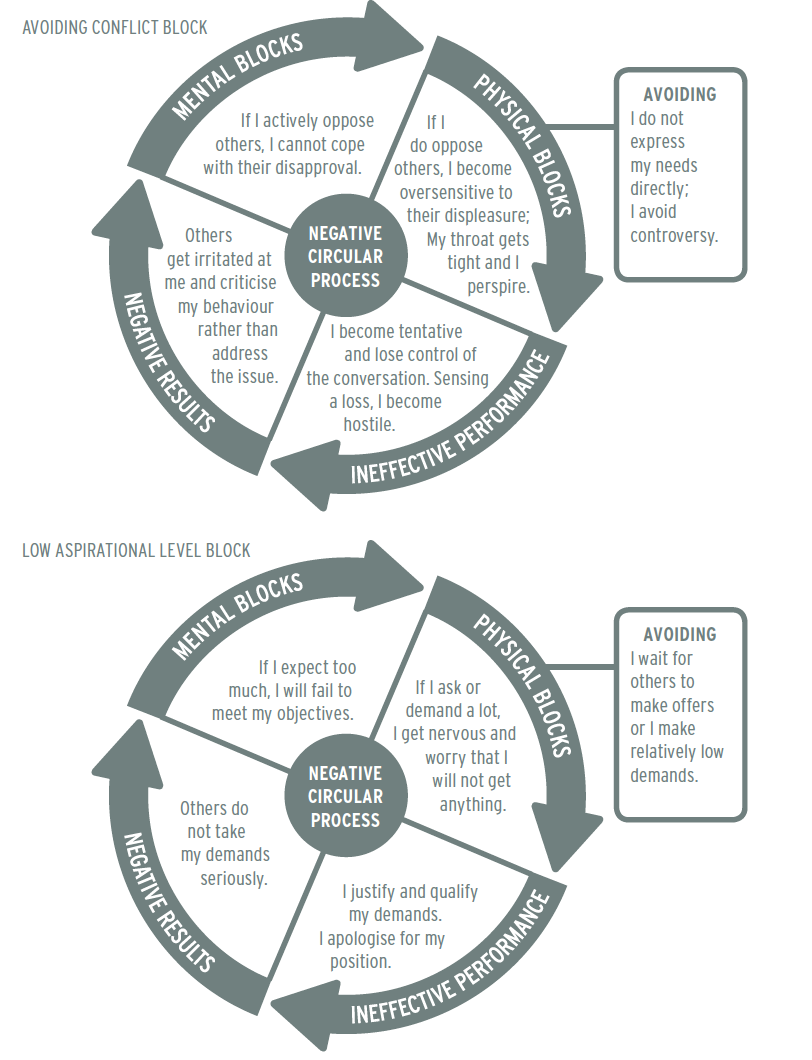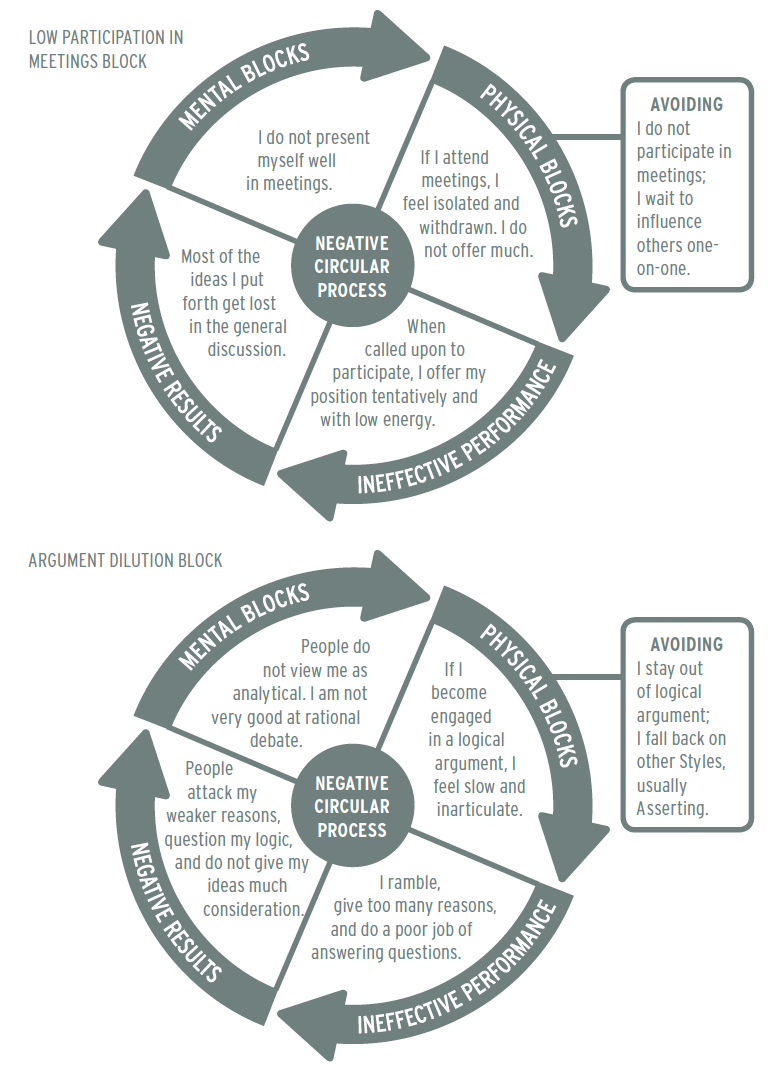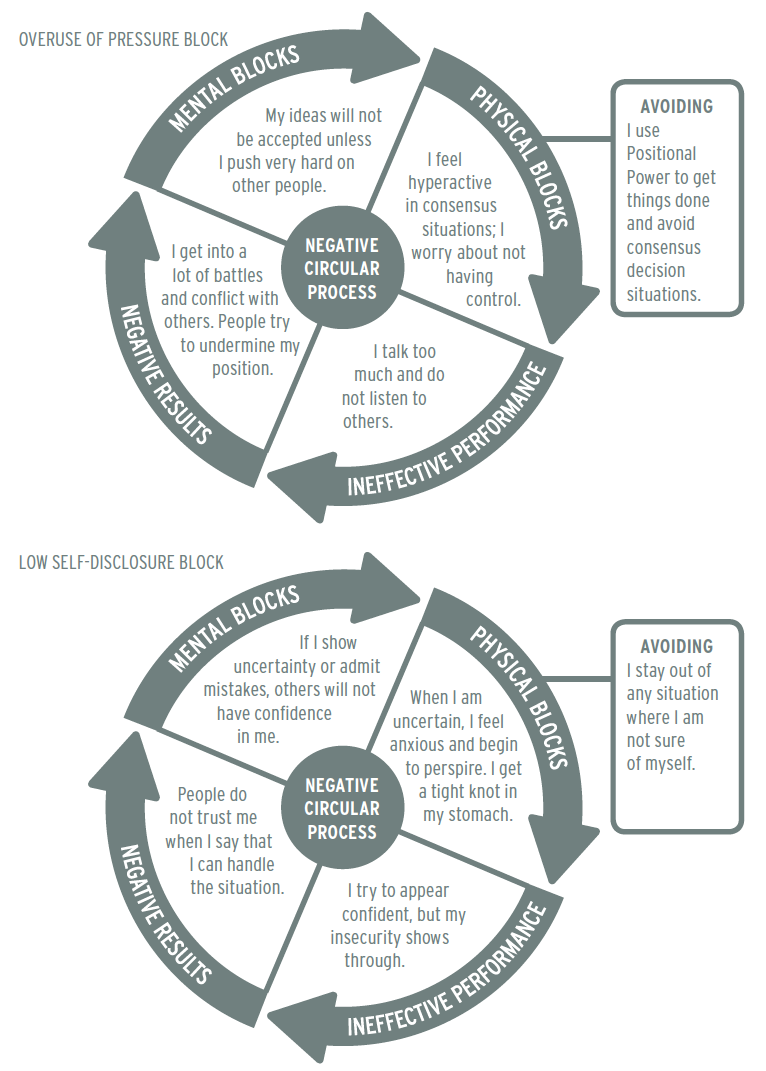There are three types of barriers you are likely to face when learning Positive Power and Influence skills: skill gaps, value conflicts, and blocks.
Skill Gaps
Inability to perform all or part of a Style or Behaviour correctly.
Skill gaps result from inexperience. If you have never before tried a Style or seen other people use it, you are likely to have a skill gap. Examples of common skill gaps for each Style include:
- Persuading: Difficulty being concise or clear when Proposing; falling into argument dilution when Reasoning.
- Asserting: Difficulty identifying Incentives and Pressures that you control and that the target values.
- Bridging: Difficulty forming open-ended Involving questions or tactically appropriate Disclosing statements.
- Attracting: Difficulty using analogies and metaphors to create a Vision of an ideal outcome.Since skill gaps result from inexperience, they usually narrow with moderate effort and practice.
Value Conflicts
The Style or Behaviour violates your personal values, principles, or standards, or it contradicts how you want to treat or be treated by others.
If a Style or Behaviour does not feel “right” to you, you probably have a value conflict. Here are some common examples:
- Persuading: You believe that a cold, logical, and unemotional approach to personal issues is uncaring and devalues others’ feelings.
- Asserting: You believe that the use of Incentives is the same as bribery.
- Bridging: You feel that getting too personal in work situations is inappropriate.
- Attracting: You feel that the Behaviours are manipulative and lead people “down the garden path”.
Value conflicts are the “shoulds” and “should nots” you have about a Style. They are often situational. For example, perhaps you think that Asserting is an appropriate Style to use with your peers but not with your manager – you do not think you have the right to use it upward. This is a situational value conflict.
Resolving value conflicts does not require changing your personal values. Your values are an important part of who you are. Instead, carefully analyse each value conflict you have. Begin by identifying the personal value or belief you believe is at risk. Then ask yourself, “How can I alter my performance of the Style to fit my values?”
Blocks
Mental messages and/or physical sensations that interfere with your performance of the Styles or Behaviours.
If one or two Styles or Behaviours resist your efforts to master them, you may be “blocked”. Here are some telltale symptoms:
- You are unable to overcome a skill gap in spite of repeated attempts to use a Style.
- You truly believe that a Style is consistent with your values and beliefs, but negative thoughts about it often creep into your mind.
- You are able to perform a Style correctly, but you feel physically uncomfortable using it and are often disabled by these feelings.
Blocks cause physical and mental stress. Stress can absorb your personal energy, causing the gap between your available energy (power) and your applied energy (influence) to stubbornly persist. As a result, you will not be as effective an influencer as you would like to be.
Blocks are significant barriers to developing Influence Style flexibility. You will need to understand and work through them before you can master any Style or Behaviour.
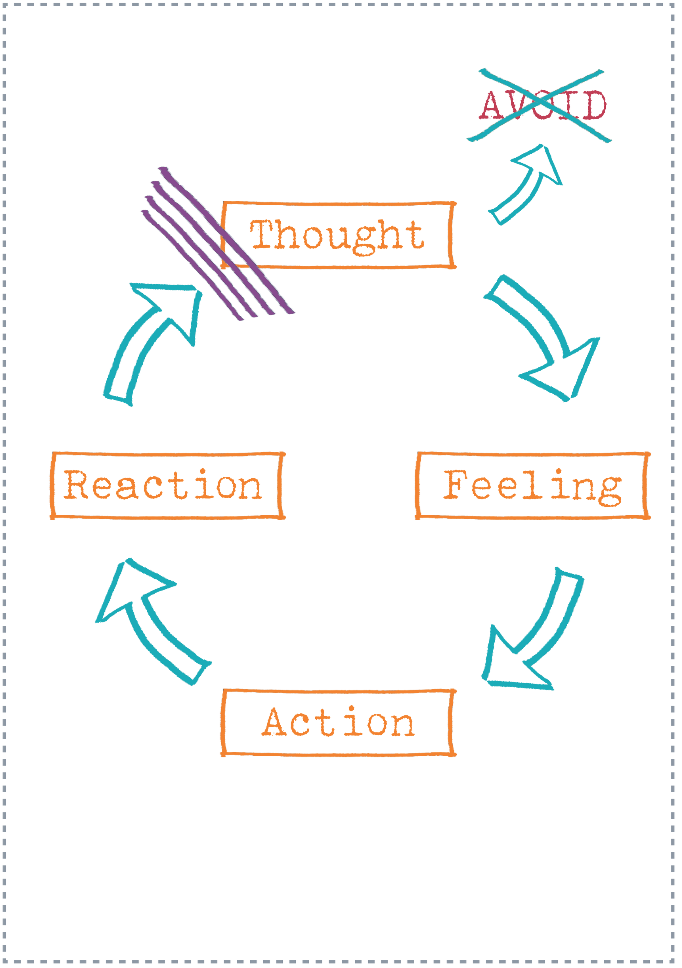
The Negative Circular Process
Blocks are complex. They interact with each other and with the influence situation in a self-reinforcing, closed loop or chain reaction. We call this chain reaction the negative circular process.
Here is how the process works:
- Mental blocks lead to or combine with physical blocks to create stress and divert your attention from the influence task.
- The stress and discomfort caused by mental and physical blocks lead to ineffective performance. You are unable to perform the Style correctly or your overall performance suffers.
- Ineffective performance leads to negative results or failure to reach your objective.
- Negative results confirm and reinforce your mental block(s).
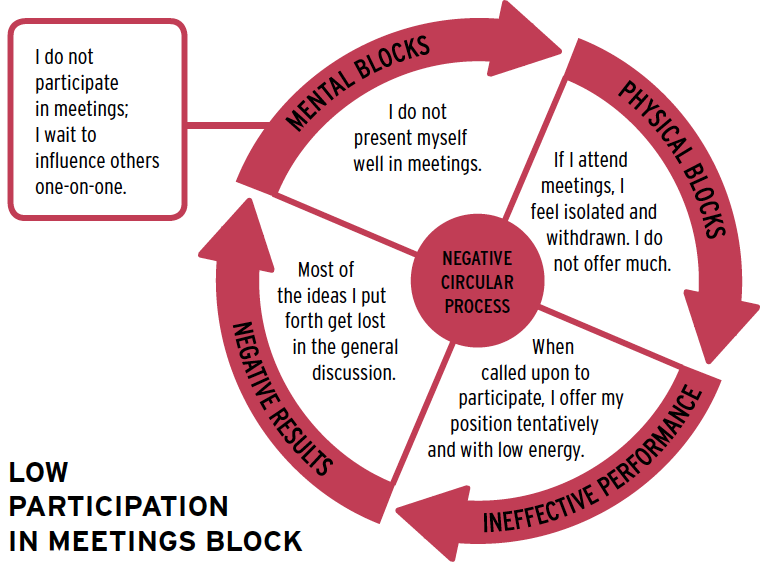
This repetitive cycle of negative thoughts, feelings, actions, and results makes most people want to avoid using the new skill altogether. After all, how much negative reinforcement are you willing to endure before you give up trying? Avoiding behaviours may include falling back into an old familiar Style or Avoiding the situation entirely.
This example shows a typical block to developing the Push Styles. You will find additional examples in Reading 6 in Managing Influence, “Blocks to Developing New Skills”.
Diagramming the Negative Circular Process
The first step in working through blocks is to diagram the negative circular process. Blocks operate “in your head”. Often you are not even aware of them. Externalise them by getting them out of your head and down on paper.
Use your experiences in the Tracks to analyse your blocks. Do not be theoretical; use your actual experience as a source of data. You can then introduce improved techniques into your next experiment. If you fabricate results or theorise about what your experience might have been, you risk making your next practice attempt off-target.
Start filling in the circle at the point where you had the most difficulty. For example, if you bombarded yourself with negative mental messages, but you were unaware of any physical blocks, performance problems, or negative results until the feedback session, your greatest difficulty stemmed from a mental block. Fill in that segment of the circle first. If ineffective performance or negative results absorbed most of your awareness, start there.
Complete the circular process from the point where you started. Once you have noted your most difficult experience, complete the circle. Concentrate on what really happened. Ask your exercise partners what they saw or to hypothesise about the nature of your block. Use their feedback to confirm your experience. If necessary, ask your trainer for help in completing this difficult but important step.
Describe your Avoiding behaviour. You may have substituted a more comfortable Style for one that produces more discomfort, or you may have abandoned the Style (and even the Influence Objective or situation) entirely.
Develop the circle. Once you have the broad headlines, you may remember additional details of your experience. Add these details to the diagram. They will support the next steps you take in working through blocks.
Focus on improving your performance. Correct performance is the most powerful “block buster” you have. Other techniques can help you work on the nonperformance elements of the circular process. For example, neutralise a mental block by bombarding yourself with positive thoughts about your capabilities. Use stress reduction exercises to help ease physical blocks. Counterbalance an obsession with negative results by focusing on the positive aspects of your work.
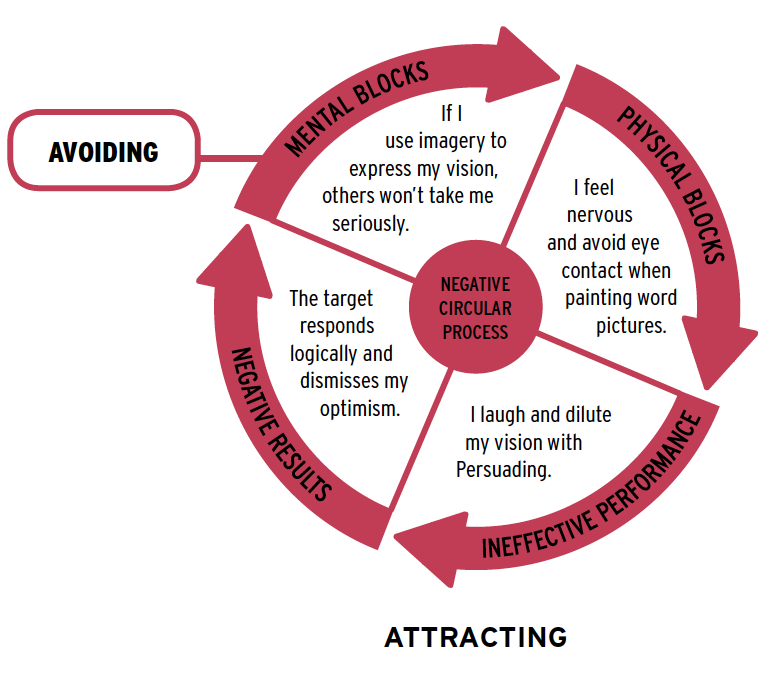
Diagramming the Positive Circular Process
Once you have identified and diagrammed your negative circular process, turn it around. Make the circular process work for you positively.
Start by filling in the “Effective Performance” portion of the positive circular process diagram. Write a statement that is the positive opposite of your ineffective performance statement.
Complete the positive circular process diagram. Theorise about the positive results that may occur as a result of performing the Style or Behaviour effectively. Speculate about the positive mental energy you may experience—self-confidence, optimism, creative performance ideas, and so on. Then, speculate about the positive physical energy that will naturally flow from your efforts. Fill in the rest of the circle, then examine and absorb it.
Carry a mental picture of this positive circle with you into your next Skill Practice Exercise. Make your correct performance statement your learning goal for that exercise!
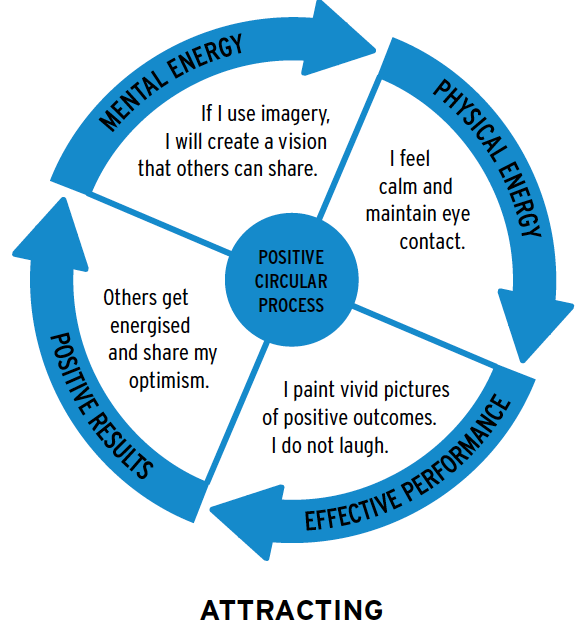
Working Through Blocks
Use these diagrams to work through your block.
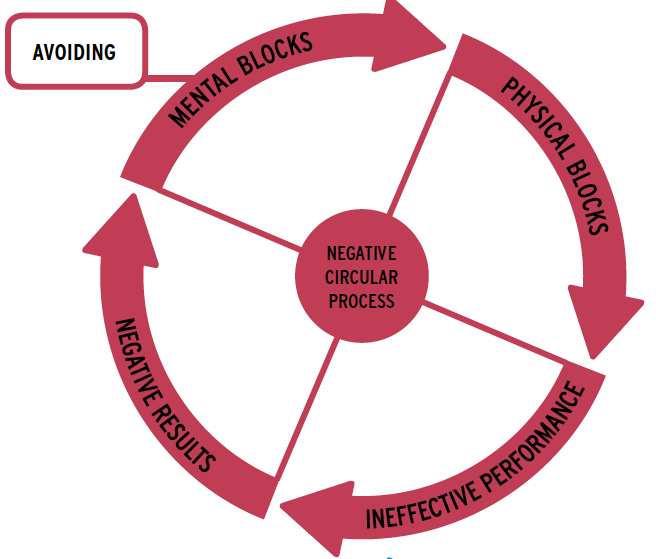
Negative Circular Process
Diagram your negative circular process. Start at the point on the circle where you had the most difficulty. Then, move to each successive item in the sequence until the circle is complete.
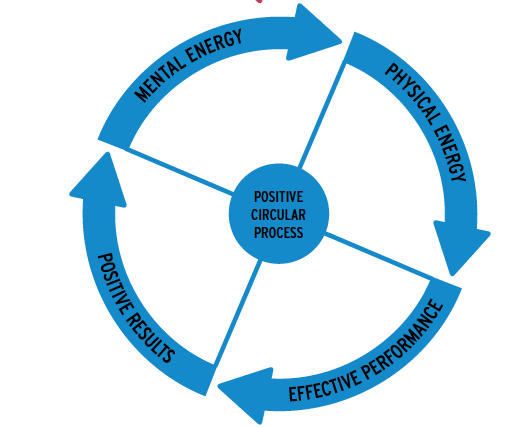
Positive Circular Process
Turn your negative circular process into a positive circular process. Start by filling in the “Effective Performance” portion of the diagram. Write a statement that is the opposite of your ineffective performance statement on the previous page. Fill in the rest of the circle from there.
Blocks To Developing New Skills – Further Reading
Introduction
Blocks are mental messages and/or physical sensations that interfere with your performance of the Styles or Behaviours. If one or two Styles or Behaviours resist your efforts to master them, you may be ‘blocked’.
Here are some typical symptoms of blocks:
- You are unable to overcome a skill gap in spite of repeated attempts to use a Style.
- You truly believe that a Style is consistent with your values and beliefs, but negative thoughts about it often creep into your mind.
- You are able to perform a Style correctly but you feel physically uncomfortable using it and are often disabled by these feelings.
How blocks work
Blocks are complex. They interact with each other and with the influence situation in a self-reinforcing, closed loop or chain reaction. We call this chain reaction the negative circular process.
Here is how the process works:
- Mental blocks lead to physical blocks and, sometimes, Avoiding behaviour. Mental and physical blocks create stress and divert your attention from the influence task.
- The stress and discomfort caused by mental and physical blocks lead to ineffective performance. You are unable to perform the Style correctly or your overall performance suffers.
- Ineffective performance leads to negative results or failure to reach your objective.
- Negative results confirm and reinforce mental block(s).
This repetitive cycle of negative thoughts, feelings, actions, and results makes most people want to avoid using the new skill altogether. After all, how much negative reinforcement are you willing to endure before you give up trying?
Elements of the Negative Circular Process
1. Mental blocks lead to physical blocks and, sometimes, Avoiding behaviour.
Mental Blocks
- You are especially vulnerable to negative beliefs when developing new skills.
Perhaps there are valid reasons to think that your negative beliefs are true. You may not know exactly what you are doing, or you may not be perfect the first time. Knowing that making mistakes is normal can be comforting, but this knowledge will not necessarily stop you from having negative beliefs anyway.
- Negative beliefs are not always bad; they often protect you from harm.
Suppose you wanted to learn how to roller skate, but you also believed you were too uncoordinated. This belief would increase your caution the first few times you strapped on your skates. A number of warning thoughts would flood your mind. You might picture yourself lying in a tangled heap at the bottom of a hill. You would stop and compare your self-perception to the reality of the situation. Looking down the slope of the hill, you would assess your ability (balance, agility, coordination, and so on) to skate down it safely.
- These normal, constructive concerns would protect you from danger and unnecessary risk-taking.
However, these same concerns would be disabling if they prevented you from skating when conditions were safe or from trying to skate at all. Negative thoughts would distract you and jeopardise your success. Bad experiences from the past — old fears — might come back to haunt you. You might think yourself into failure and experience the disastrous results that you feared.
- Negative beliefs are not always under our conscious control.
Eliminating them is not just a matter of placing them into perspective or dismissing them as irrational. Talking yourself out of them is not easy to do.
- When negative beliefs become disabling they form a mental block.
Mental blocks often occur in learning situations: normal concerns get magnified and healthy caution becomes a disabling fear.
- Learning new skills can be even more difficult when people are watching you.
Imagine learning to skate in the presence of people who are experts — real or imagined. You would probably feel even more self-consciousness than if you were alone. Fears that they might judge or laugh at you would intensify, deeply affecting your performance.
- Because influence always involves an audience, mental blocks can be very powerful.
The opinions of others magnify in importance. Self-consciousness, worries, concerns, and fears about performance multiply. Some mental blocks come from comparing yourself to others (Will I do as well as they do?). Others stem from fear of losing power (Will I jeopardise my position by doing this?). Self-image may come into play (How will I look in this situation?). Be aware of how the presence of others affects your negative thinking. This awareness will provide clues to the exact nature of the block.
- When faced with a mental block, we often take refuge in Avoiding — and for good reason.
Few people would enter a door marked ‘Danger’. Mental blocks are danger signs warning us about the use of the Influence Styles. The sensible response to danger is to take an alternate route where no such danger exists. If you were learning to roller skate, you might remove your skates and walk, instead of roller skating down that big hill. The downside is that you would miss the opportunity to increase your skills by learning to skate in risky situations.
- The safer alternative in influence situations is to use a more comfortable or familiar Style.
It becomes our ‘default’ Style. However, the safer, more comfortable Style may not be the Best Style for the Objective (BSO). You might achieve less because of your caution. For example, if your BSO is Persuading, a block you might have is, ‘I am not good at thinking on my feet.’ You might fall back on a less thinking Style like Bridging, thus losing the opportunity to engage the target in a rational discussion, and sacrificing the many other benefits Persuading has to offer.
Physical Blocks
- Physical blocks stem from mental blocks.
They develop when you cannot or choose not to avoid a situation in spite of your mental blocks. Physical blocks occur when you force your body to do something that your mind thinks is dangerous. They appear in a variety of stress symptoms such as rapid heartbeat, sweaty palms, and shaky knees. Sometimes these physical symptoms are visible to others, such as poor eye contact. Other times, they are hidden from view but still very much felt by the influencer.
- It is normal to experience physical stress when taking risks.
Your body tries to hold you back to prevent you from failing or jeopardising your survival. You feel internal discomfort, unpleasant feelings, sensations, and other organic symptoms.
- Physical stress, like negative beliefs, is not always bad.
Think of what your automatic response might be to oncoming traffic as you crossed a busy street on new roller skates. Your adrenaline would pump and you would probably be afraid. Your entire body would try to get you out of the way of something that might hurt you. Your physical stress would save your life.
- When physical stress becomes disabling, it forms a block.
Like mental blocks, physical blocks divert your attention from the influence task and lead to Avoiding behaviour. Instead of focusing on your Influence Objective, you focus on quieting your shaky knees, pounding heart, or jumpy stomach. It will be hard for you to remember the correct skating movements when your teeth are chattering and your knees are quivering.
2. The stress and discomfort caused by mental and physical blocks lead to ineffective performance.
Ineffective Performance
- While mental and physical stress can protect you from harm, they can also impair your performance.
If you roller skated into busy traffic in the grip of physical stress, you would not perform very well. You would probably stumble, fall, lose your form, or slow down — none of which would be a good idea in busy traffic!
- Blocks can lead to performance disruptions in influence situations, too.
They can interfere with your concentration and undermine your confidence, making it hard to perform the Style or Behaviour correctly with strength, purpose, and conviction.
3. Ineffective performance leads to negative results.
Negative Results
If you lost your balance, looked awkward, or slowed down to a stop when roller skating, you might feel like a failure. If you fell, pulled a muscle, or chipped a tooth, the memory of this event would be even stronger and more painful. If a car narrowly missed you, this frightening experience might permanently reduce your confidence. You might even decide to put away your skates forever.
Failure to perform well in influence situations can lead to negative results as well. The target may react negatively and you may fail to meet your needs. You may even end up with a bigger problem than the one you started with, such as a damaged or more precarious relationship with the target.
4. Negative results reinforce mental block(s).
Reinforced mental blocks
If your attempts to roller skate resulted in injury, the message would be clear: ‘See, you were right to worry. Stay off your skates on busy streets. Forget about any plans you had to roller skate to work. Walk or take the bus like you always have.’
If your attempts to use influence skills led to negative results, the message would also be clear: ‘Don’t ever use that Style again. You tried and the target reacted badly, just as you expected. All the misgivings and reservations you had have come true.’
When your original negative belief (or other mental block) is repeatedly verified and reinforced by negative results, you may eventually Avoid. Avoiding behaviour protects you from the pain of negative results, but it also keeps you from achieving successes and accomplishing goals.
Examples of the Negative Circular Process
Here are some examples of the negative circular process for each Style.
Mental Block: ‘I am not good at thinking on my feet.’
Physical Block: I freeze when the target surprises me with strong counter-arguments to my proposal and reasons. My throat gets dry and I have trouble speaking.
Ineffective Performance: I repeat the same proposal I opened with, without tailoring it to the target. I generalise and lose my focus.
Negative Results: The target engages in heated debate with me. I either deadlock or give in.
Reinforced Mental Block: ‘I am not good at thinking on my feet.’
Avoiding: Eventually, I avoid making logical arguments or use a ‘default’ Style — the safe, familiar programmed response, maybe Bridging.
Mental Block: ‘If I bargain I will give too much away. I’ll end up losing.’
Physical Block: My heart beats fast when people make counter demands of me.
Ineffective Performance: I hear the target’s needs but miss opportunities to create incentives. My pressures are weak or I withhold them altogether.
Negative Results: The target resists or takes advantage of me by adamantly demanding more. As a result, I begin to give up more than I intended.
Reinforced Mental Block: ‘If I bargain I will give too much away. I’ll end up losing.’
Avoiding: Eventually, I fall back on Persuading, hoping that I can get what I need on the merits of the argument. I still end up losing.
Mental Block: ‘If I get too personal I will become emotional and lose self-control.’
Physical Block: I cross my arms, avoid eye contact, and send other defensive body language signals instead of warmth and openness.
Ineffective Performance: I stop Disclosing and Listening to the target’s feelings. My questions seem irrelevant or manipulative.
Negative Results: The target remains insensitive to my problem. My emotions surface and I get extremely angry.
Reinforced Mental Block: ‘If I get too personal I will become emotional and lose self-control.’
Avoiding: Instead of being seen as manipulative, I start Persuading and adopt an interview mode.
Mental Block: ‘I will look silly and feel childish being so optimistic.’
Physical Block: I laugh and avoid eye contact when painting word pictures.
Ineffective Performance: I dilute my vision with Persuading and fail to share it with the target.
Negative Results: The target responds in a logical mode while I ramble on about the future. The target dismisses my optimism as ill-founded and foolish.
Reinforced Mental Block: ‘I will look silly and feel childish being so optimistic.’
Avoiding: Confirmation of my mental block eventually drives me to use Persuading rather than Attracting. I miss opportunities to build energy and enthusiasm when I really need to.
Mental Block: ‘If I stop focusing on my Influence Objective, I will lose control of the situation.’
Physical Block: My voice gets too soft and I feel weak in the knees.
Ineffective Performance: My attempts to relieve tension are halfhearted.
Negative Results: I signal Avoiding to the target, who then escalates the attack.
Reinforced Mental Block: ‘If I stop focusing on my Influence Objective, I will lose control of the situation.’
Avoiding: Instead of Disengaging, I concede, or just give up altogether. The target feels that I am Avoiding, and the relationship is at risk.
The Process for Working Through Blocks
The Process
Think of a persistent problem you have had with a particular Style or Behaviour or a situation where you used the Style unsuccessfully (in a Track, Self-Assessment Exercise, or at work).
Diagram the negative circular process.
Using a blank diagram like the one below — you might wish to copy this page for this activity — list the mental and physical blocks that emerged from your negative beliefs. How did your blocks lead to ineffective performance? What were the negative results of your influence attempt? How did these results reinforce your blocks?
You do not necessarily have to begin your diagram at the top. Start anywhere and then fill in the blanks. If your most vivid memory is of your physical block, begin your diagram at that point on the circle. It may be easier for you to start at performance. What did people tell you in the feedback session about your ineffective performance? Perhaps you remember most clearly a negative result. What happened? What did the target do that caused you to fail in your influence attempt?
You may have difficulty identifying or describing your mental block.
Many people have this problem. It is sometimes difficult to recall the negative mental messages that cross your mind as you prepare to use a Style or Behaviour. Do not resist if this occurs. Ask yourself what kinds of negative beliefs the average person might have for such negative results to occur. Write down these beliefs now. Perhaps later, more detailed and personal insights will come to you.
Fill in the missing pieces.
As you diagram the negative circular process, elaborate on each part. You will probably remember more information about the event than you recorded in your Personal Learning Journal. We can usually recall minute details of our failure experiences. Fill in these details as you think of them.
Diagram the negative circular process either before or after your influence attempt — not during it.
It is extremely difficult to think through the process when you are caught up in it. Avoiding or negative thinking will inevitably invade your mind. You will blank out or not be able to see the separate parts of the cycle and how they link together. As a result, you will have difficulty understanding and analysing them in greater depth.
Diagramming the negative circular process unravels the mystery.
Recording your experience with the Style makes plain how the cycle feeds upon itself through each step of the process. Diagramming transforms subjective memory into concrete written information that you can view objectively. It makes visible what your mind would prefer to keep hidden.
Focus on improving your performance.
The negative circular process is a chain reaction. Like all chains, it is only as strong as its weakest link. That link is ineffective performance. By working to improve your performance, you will begin to break down the control the process has over you and reverse its course.
Elements of the Positive Circular Process
Something interesting will happen as you try to improve your performance. A positive circular process will emerge out of your negative circular process.
1. Effective performance produces positive results.
Positive results
While working to improve your performance in low-risk situations, you will immediately see the benefits of using the Style or Behaviour effectively. By getting direct feedback from your influence targets or by observing their behaviour, you will learn to be more effective and begin to experience more successes than failures. This may take repetitive practice. Remember that some of your blocks are deeply ingrained. Take your time. Stop and start as needed. Approach your work as you would a laboratory experiment. Collect data on your successes. Be realistic about what skills you still need to improve, but do not deny your progress. Progress is the source of your recovery from the block and your entry into Style mastery.
2. Positive results erode mental blocks and create mental energy.
Create mental energy
Open up your mind for discussion! Let your negative beliefs battle with the positive results achieved in your experiments. Bring some fresh air into the way you think about yourself and your influence skills. Ask others to tell you how strong you are and to point out your successes. This is more than simple positive thinking, although some of that might help too. Giving yourself permission to hear positive feedback means a willingness to accept new data about your progress. The mind is no fool where success is concerned. Success will encourage you to proceed with your experiments — carefully, of course!
3. Mental energy erodes physical blocks and increases physical energy.
Increase physical energy
At this point, your mental block will not have disappeared. It will only have stepped aside for awhile as you experiment safely. You will be introducing new thinking, data, and experiences. As a result, your interest in experimenting will increase and the stress of poor performance will begin to lift. You will have enough energy to keep trying. Relax and stay in touch with your feelings. Centre yourself. Disengage if you feel too nervous to go on. If appropriate, disclose your discomfort to your target and observers. Tell them that you are trying something new and difficult. This may make them more receptive and help you relax.
4. Physical energy leads to more effective performance.
Effective performance
Closing the loop on this new positive cycle may not occur immediately. Several repetitions may be required to set each new step into place. Before long, the positive cycle will occur every time you perform the new Style or Behaviour. The cycle will reinforce itself — each new experiment will yield more positive results and further erode your blocks.
Examples of the Positive Circular Process
Here are some examples of the positive circular process for each Style.
Your mental block tells you that you cannot think very well on your feet, so you decide to improve your ability to respond to logical arguments. As you practise in exercises and simulations, you produce positive evidence that you can respond to arguments effectively — perhaps haltingly at first and with great effort — but you can do it. You develop the ability to stand up for your ideas and to provide rational justification for them. Others listen to your arguments and respect them — and you — as well. You develop a belief in your ability to think clearly when others challenge you. The more you practise, the more comfortable and energised you feel. As your performance improves, your blocks no longer control you, nor do you avoid by slipping into easier but less appropriate Styles.
You have never had confidence in your ability to bargain, so you practise using incentives and pressures in low-risk situations. To your surprise, you frequently succeed in reaching agreements with your targets and get what you want. You start believing in your ability to confront others. Your heart does not beat as fast as before in these situations. Bargaining becomes less stressful, perhaps even fun. You work even harder to create incentives that will appeal to the target, while holding firmly to your position. You get more out of agreements than you expected, and your confidence in your ability to bargain grows.
Your fear of showing your emotions blocks you from Disclosing, so you decide to practise Disclosing to see if you really do lose control. As you practise, you notice that when you disclose, the target does the same. You learn that Disclosing relieves emotional tension rather than adds to it. You remain relaxed, focused, and attentive. You do not break down. You come to realise that maybe you can handle emotional situations. Sitting through intensive disclosure sessions is not as painful as it used to be. You see the value of going below the surface to explore the difficulties between yourself and others.
You feel embarrassed using word pictures when visioning, even though you really do have some rich mental images of what you want to have happen in the future. By sharing these images in a safe environment, you energise others and get them to share your optimism. Your embarrassment fades and your natural optimism takes over. You relax and let the mental imagery flow freely. These positive results energise and motivate you to continue practicing and improving.
You fear losing control if you let go of a tense situation. You decide to practise the four Disengaging actions with strength and purpose. You feel less shaky and your voice becomes stronger. You begin to gain agreement from others to back off and cool down. You reenter the process and achieve your objective. People clearly respect you more. They do not perceive you as Avoiding. You begin to see that you can actually gain control of a situation through Disengaging. This gives you the courage to use Disengaging more tactically.
Sustaining you progress
Use the diagram to turn the negative circular process you previously described into a positive circular process.
In time, the positive circular process will take over. However, your old negative patterns may not disappear entirely. When risk escalates, they may return. By that time, you will know and recognise them for what they are. They will have less power over you. Continued practice and careful planning will eventually displace them.
Examples of Typical Blocks
Typical Blocks to Developing Push Styles
Typical Blocks to Developing Pull Styles
